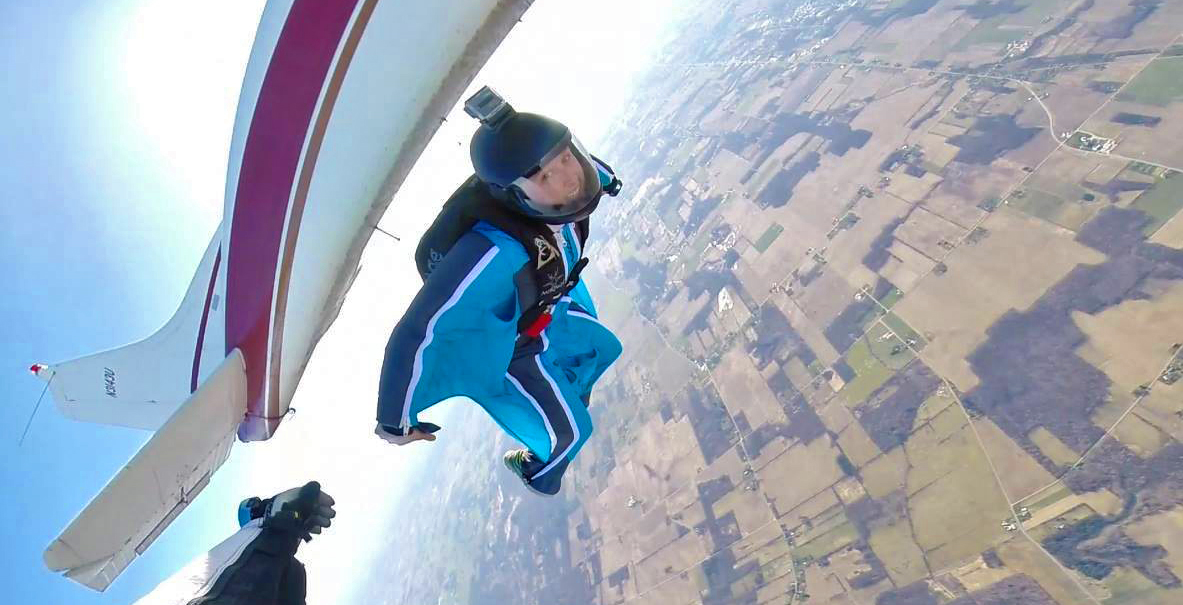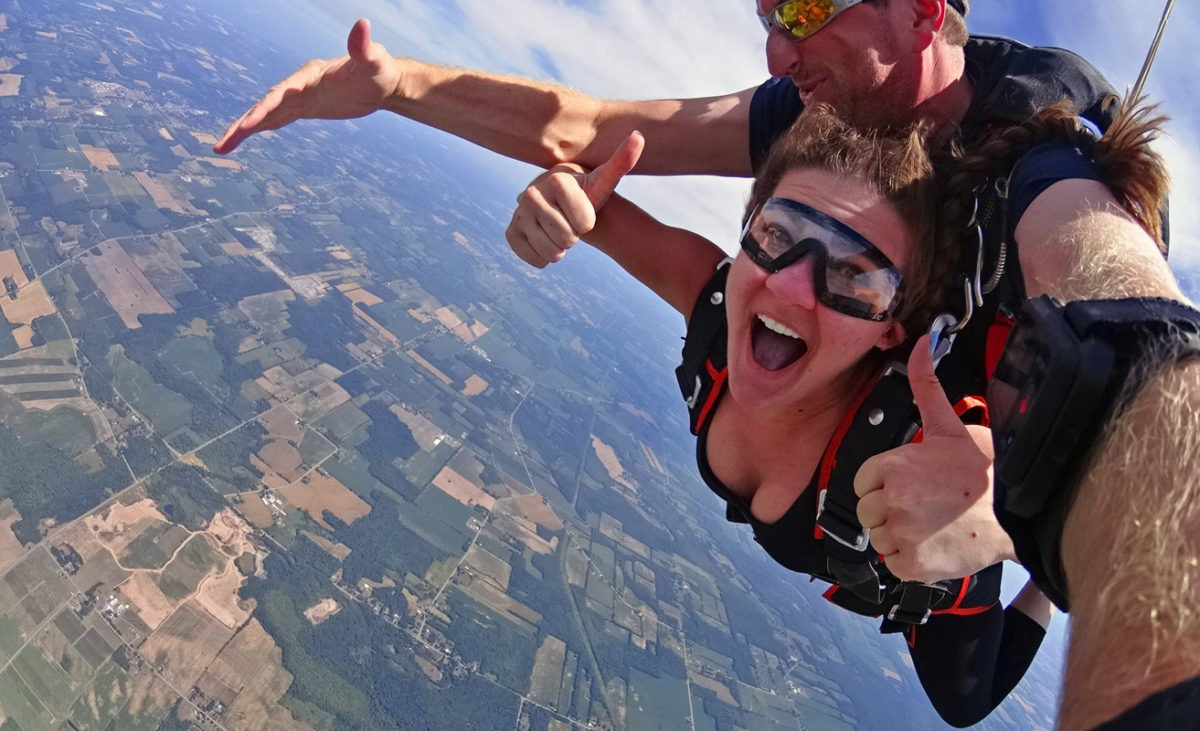Because skydiving equipment engineers are always hard at work to continually develop and improve the sport of skydiving, skydiving gear is constantly advancing.
Due to the hard work and dedication of bright minds within the skydiving community and without, there have been many skydiving equipment breakthroughs and new and exciting skydiving accessories that are downright impressive. Trust us, being at the forefront of a burgeoning sport is not easy. Here’s just what these skydiving equipment marvels have come up with!
1. Automated Activation Device (AAD)
One of the most important pieces of skydiving equipment available to skydivers is the Automated Activation Device. Despite being given a bad rap as reckless daredevils, which frankly isn’t true, skydivers want peace of mind. The premise behind the Automated Activation Device is simple: in the event something is amiss, skydivers want a piece of skydiving equipment that ensures a parachute is open above their heads at the proper time. While the premise behind this critical piece of skydiving equipment is simple, the practical creation of a 100% reliable, minuscule, portable, uber precise computer was anything but.
Enter, Helmut Cloth. Helmut Cloth dedicated years of time, energy, and money to creating a device that would operate perfectly, and he succeeded. The device he created, specifically, is called the CYbernetic Parachute RElease System (or CYPRES for short). In addition to the CYPRES, there are now other Automatic Activation Devices on the market. Each of these neat pieces of skydiving gear has the same goal at the heart of their creation: to make the sport of skydiving safer with reliable, effective skydiving equipment.
2. FlySight
This piece of skydiving equipment is primarily utilized in two popular skydiving disciplines: wingsuiting and swooping. The FlySight is a GPS receiver that can be used to track a wingsuit pilot or canopy pilot’s glide ratio, horizontal speed, or vertical speed. After the skydive, a jumper can review his or her flight data as a graph with plotted points. The graph allows the jumper to measure glide ratio, horizontal speed, vertical speed, and elevation against either time or distance. By providing critical detailed feedback, the FlySight allows experienced skydivers to hone their performance and develop their skills.

3. Audible Altimeter
An audible altimeter has nearly become a staple piece of skydiving equipment, and many skydivers won’t jump without it. Though it is recommended that each licensed skydiver wear an altimeter (either digital or analog) to maintain altitude awareness, at times during a skydive, a jumper can become distracted or unable to orient themselves enough to determine their altitude.
An audible altimeter uses an aural cue (tone, beep, or siren) to help keep skydivers aware of their altitude during each of their jumps as well as during parachute flight. Audible altimeters can be preset with various “warning” altitudes.
For example, in an audible that can be preset to three warning altitudes, the first alarm will often be set to indicate to the skydiver that, if jumping in a group, it is time for the fun to end and for a jumper to begin moving away to create separation and distance between individuals before their parachutes are deployed. The second alarm will be often set to go off at an ideal altitude to indicate to the jumper it is time to deploy the parachute. The third alarm is much more aggressive tonally (think wailing siren instead of persistent beep). This alarm is set for an altitude where danger is becoming imminent. The third alarm tells a skydiver they need to make a decision and make it quick.
4. ColorAlti
Now knowing the basics of how an audible altimeter works, it’s easy to see that there would be some inherent issues with using an audible altimeter for hearing impaired skydivers. This is a problem that the ColorAlti, though not developed exclusively for, neatly solves. The ColorAlti is a piece of skydiving equipment developed by Freefall Data Systems LLC that uses peripheral vision LED’s within a helmet to display a hue of light that changes based on a jumper’s altitude. How’s that for cool skydiving gear!?
5. Bluetooth Wireless Communication Systems
Okay, admittedly, this piece of “skydiving gear” was not developed with skydiving in mind, but it certainly fills a need! Here’s the thing: while on a skydive, falling at 120 mph or gliding swiftly along in a wingsuit, you can’t hear much, which certainly makes situations that require a bit of finesse quite difficult. The ability to communicate effectively between skydivers through the use of bluetooth communication systems is being used in multiple disciplines. Professional canopy pilots use them to communicate with each other as they flock together and create formations, flying tightly together and often at speeds around 60 mph. The use of Bluetooth wireless communication systems are also becoming popular in wingsuiting. Because of the restricted position of the arms/hands during wingsuit flight, it is not easy for instructors to give hand signals (the classical skydiving communication method) to relay information to their students. More and more wingsuit instructors are taking advantage of bluetooth communication systems to help improve instruction in flight and create better wingsuit pilots.

6. Reserve Static Line and Main Assisted Reserve Deployment (MARD)
We really do love our acronyms in skydiving. Above we have mentioned two incredible, lifesaving pieces of skydiving gear that work together and are particularly helpful in sticky situations. Albeit rarely, there is a chance that there can be an issue with the main skydiving parachute which will require a jumper to disconnect the main parachute and utilize the secondary parachute, which we call the reserve parachute. The RSL and the MARD are pieces of skydiving gear dedicated entirely to making this process as safe and seamless as possible. Here’s how it works:
A Reserve Static Line (RSL) is attached to the main parachute and as the main parachute is “cut away” it pulls a pin to begin the deployment process utilizing a spring-loaded reserve pilot chute which pulls the reserve parachute out. Skydivers generally deploy their secondary parachute manually. However, in the instance they are unable to do so, the RSL assists in the process.
A MARD is like an RSL supplement. The MARD is a type of reserve static line which actually uses the drag of the main parachute to assist in the extraction of the reserve parachute. As the main parachute leaves, it acts as one GIANT reserve pilot chute tugging along at the reserve parachute to completely extract it much more quickly. The MARD helps the entire process to happen much more quickly and efficiently—potentially reducing the amount of time it takes to deploy the reserve canopy to as little as .5 seconds. Now, that’s a quick fix.
And, there you have it: 6 cool pieces of skydiving gear you didn’t know about. We hope you learned something new! If you have any questions, feel free to reach out to WNY Skydiving today!





